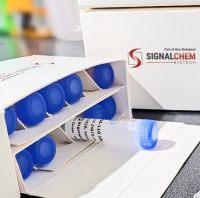Biology of p53 and SV40 Large T Association
互联网
1042
p53 was discovered because of its capacity to bind to SV40 large T antigen (SVLT) in transformed cell lines (1 ,2 ). It is a phosphorylated, 393 amino acid protein, with five blocks of sequences that are highly conserved throughout evolution. Early research showed that p53 could act as a dominant oncogene; however, comparisons at the DNA level of cloned p53 from different tumor cell lines showed that these results represented the action of the mutated rather than the wild-type gene, and that the product of the wild-type gene had a tumor suppressor activity instead (3 ,4 ). p53 is the most frequently mutated gene in a variety of malignancies, as well as in transformed cell lines (5 ); inactivation of p53 is generally associated with loss of the wild-type allele. In other cases, such as the Li-Fraumeni Syndrome, where one allele is in the form of a dominant-negative mutant, both the mutant as well as the wild-type allele can be detected (6 ).








